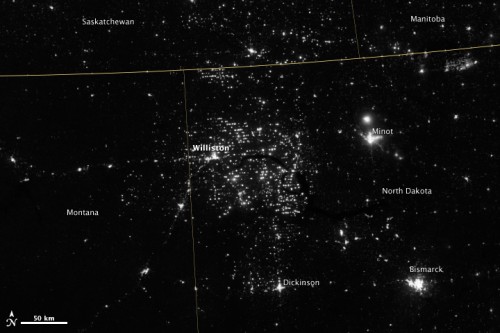
The light from natural gas flares burning in North Dakota’s Bakken oil field can be seen from space. (Courtesy: NASA Earth Observatory)
By Margaret Harris in Chicago
The environmental risks of shale-gas production are real, but the things people worry about most aren’t necessarily the ones that cause the most damage. That was the message of this morning’s AAAS symposium on “Hydraulic Fracturing: Science, Technology, Myths and Challenges”, which featured talks on the social implications of hydraulic fracturing as well as the risks of water and air contamination.
Hydraulic fracturing, or “fracking”, involves drilling a well and filling it with a high-pressure mixture of water and other chemicals. These high pressures cause nearby rock formations to fracture, releasing trapped oil and gas. According to the first speaker, energy consultant David Alleman, fracking and horizontal drilling have “revolutionized the energy picture in the US”: a few years ago, the country imported 60% of the oil it consumed, but today the figure is just 30%.
The fracking revolution has, however, generated costs as well as benefits. As one of the later speakers, Michael Webber, put it, “Shale production has environmental risks, and most of them are water-related.” Fracking consumes, on average, 5–10 litres of water for every litre of oil produced – about twice as much as conventional oil production – and the water that returns to the surface during the “flowback” stage of well production is often contaminated with natural radiation from deep rock formations, as well as added chemicals. In Webber’s view, the risks associated with this returned water are greater than the risks of groundwater contamination during the fracking stage, even though most public attention has focused on the latter.
Treating and reusing the fracking fluid would, of course, reduce both the amount of waste generated and the overall amount of water required – a big deal in the US, where many intensively fracked regions are currently experiencing severe drought. The treatment process would be energy-intensive, Webber acknowledged, but some well-heads have more energy than they can handle: fully one-third of North Dakota’s fracked gas is flared off at the well-heads because it can’t be transported cheaply, and light from the flames can be seen from space (see photo above). If instead that gas were used to power regional water treatment centres, air and water pollution would both drop. The bottom line, Webber concluded, is that constraints on water and energy are coupled – you need water to get energy, but it also takes energy to clean up the water afterwards.
The hydraulic fracking for gas and petrol is much more complex and with more far reaching conséquences than the normal extraction of petrol and gas. Hence, the need for a careful analysis of the process for the different environments and the geological structures.